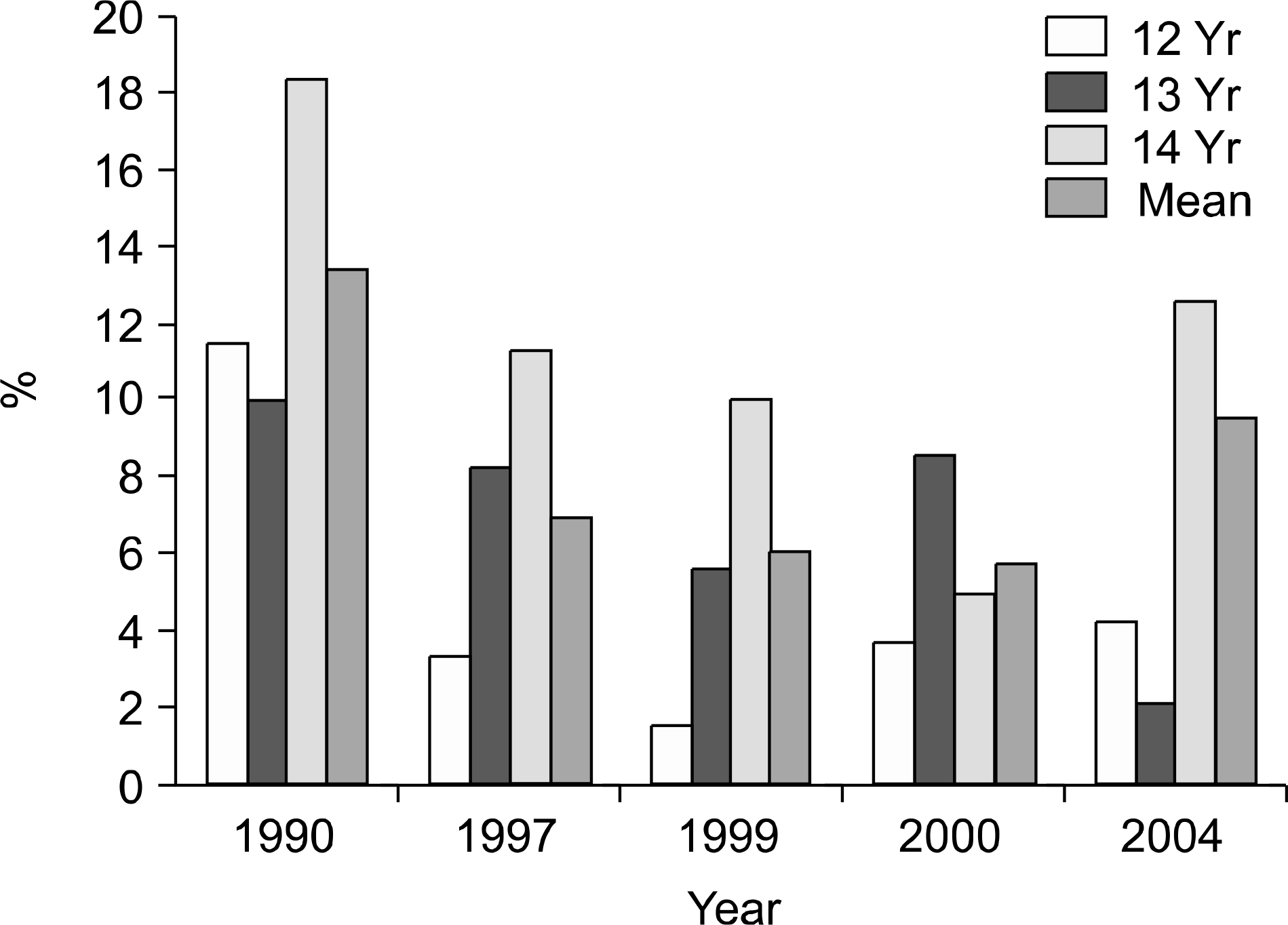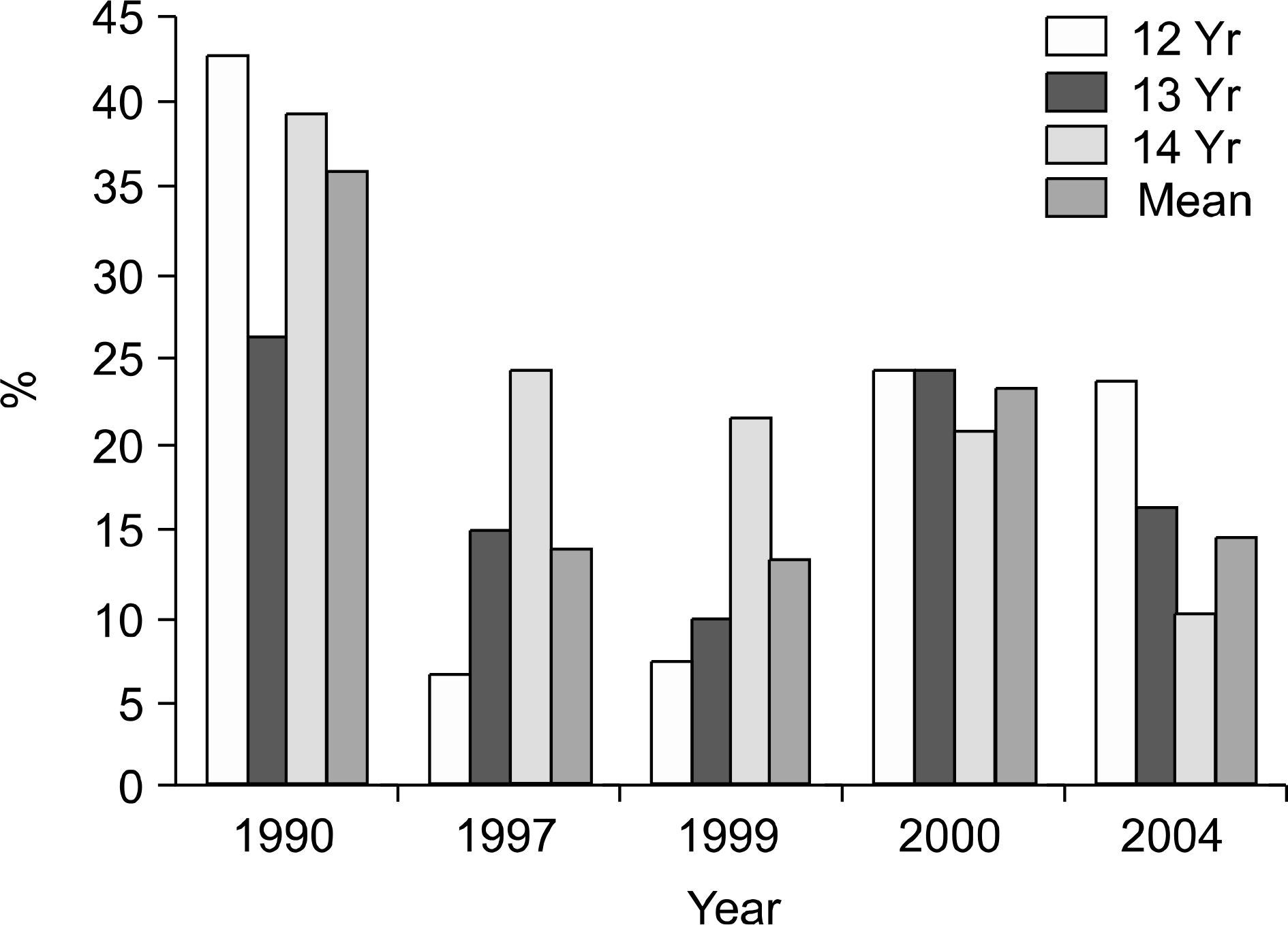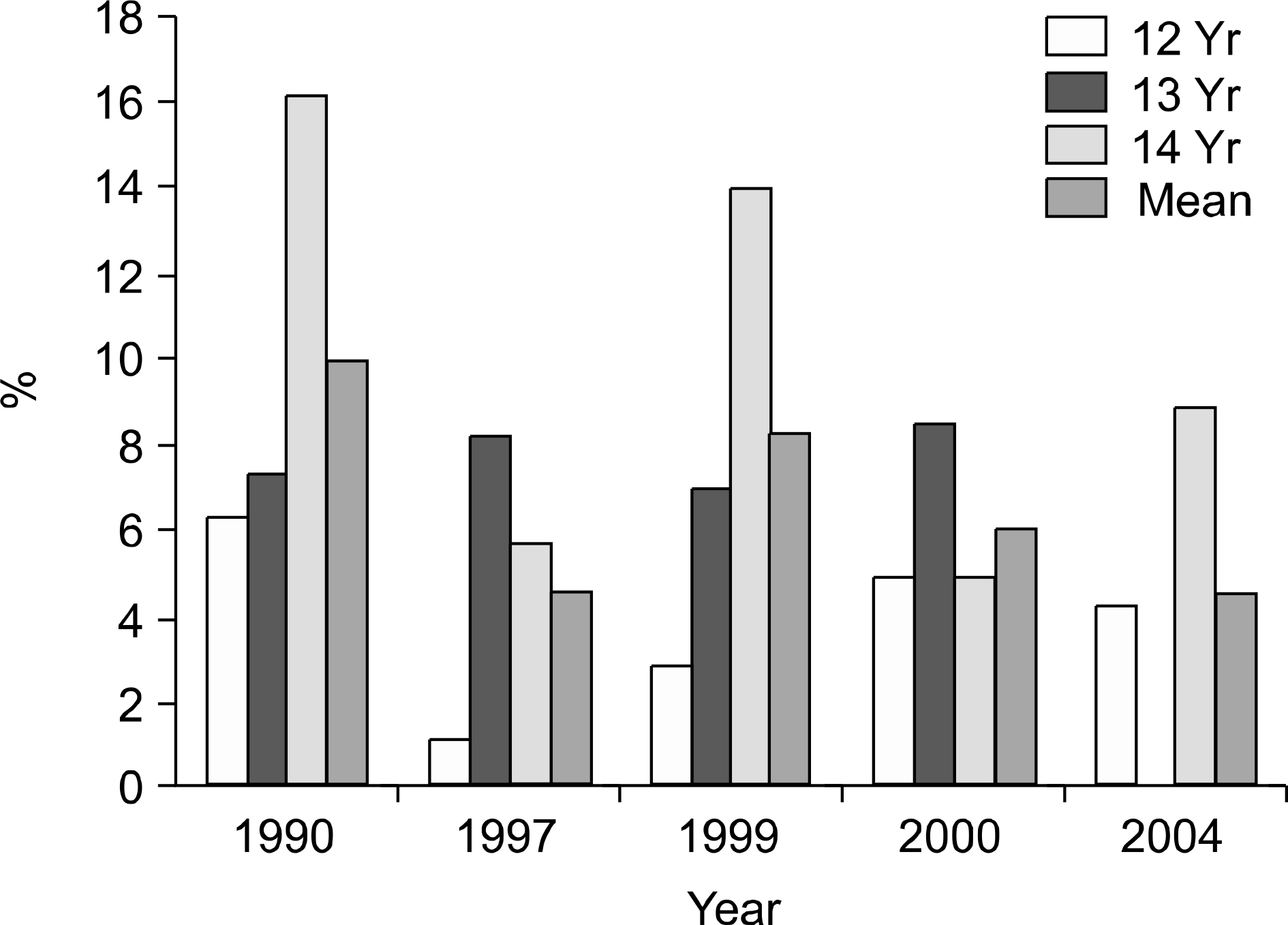Abstract
Background
Iron deficiency (ID) in Korean adolescents still remains a problem. This study aimed to assess the prevalence of iron status and investigate the relationship between the iron status and obesity.
Methods
Hematological examinations were performed on apparently healthy 12~14 year old students (M: F=451: 442) living in Incheon during September, 2004. ID was defined as a serum ferritin concentration <10ng/mL. The diagnosis of iron deficiency anemia (IDA) was established when anemia (male <12.5g/dL, female <12g/dL) was associated with a ferritin level <10ng/mL and/or transferrin saturation <16%. Using age- and gender-specific BMI percentiles, overweight was defined as a BMI=85th percentile.
Results
The prevalence of ID and IDA were 8.4 and 15.6% and 0.9 and 4.5% in males and females, respectively. Using an analysis based on the BMI, the prevalence of obesity were 21.8 and 16.2% in males and females, respectively. The prevalence of ID in male students was decreased in the obesity (0.0%) compared with the non-obesity group (11.4%). In female students, ID showed a higher frequency in the non-obesity (20.4%) compared with the obesity group (12.0%).
Conclusion
Iron deficiency still remains a major nutritional problem in adolescent females, with the prevalence of obesity significantly increasing. Although no association between the prevalence of iron deficiency and obesity was shownin this study, it is important to screen for iron deficiency and obesity, and provide effective nutritional education. Furthermore, the association of obesity with iron deficiency in relation to eating behavior should be investigated.
Go to : 
REFERENCES
1). Nead KG, Halterman JS, Kaczorowski JM, Auinger P, Weitzman M. Overweight children and adolescents: a risk group for iron deficiency. Pediatrics. 2004; 114:104–8.

3). Kim JK, Ko EY, Lee YJ, Jun YH, Hong YJ, Kim SK. Nutritional assessment and the effectiveness of dietary counseling in infants and young children with iron deficiency anemia. J Korean Pediatr Soc. 2003; 46:95–100.
4). Glader B. Iron deficiency anemia. Behrman RE, Kiegman RM, Jenson HB, editors. editors;. Nelson Textbook of Pediatrics. 17th ed.Philadelphia: WB Saunders Co;2006. p. 1614–6.
5). Abrams SA. Iron requiremnets and iron deficiency in adolescents. 2004. www.uptodate.com.
6). Kim SK. Iron deficiency anemia in children and adolescents. Korean J Pediatr. 2004; 47(6 suppl):231S–41S.
7). Looker AC, Dallman PR, Carroll MD, Gunter EW, Johnson CL. Prevalence of iron deficiency in the United States. JAMA. 1997; 277:973–6.

8). Kim YK, Kang BY, Hong YJ, Son BK, Kim KH, Kim SK. Iron deficiency anemia and iron nutrition in adolescent female athletes. Korean J Pediatr. 2004; 47:1041–6.
9). Hah JO, Kang MH, Kim JH. Prevalence study of anemia among urban and rural middle school girl students. J Korean Pediatr Soc. 1990; 433:1087–96.
10). Kim TW, Kim MH, Hong YJ, et al. Iron status in adolescent and university students in Inchoen. Korean J Hematol. 2001; 36:311–7.
11). Cho JR, Kim SK, Park SK, Hah JO. Anemia and serum iron status in adolescent female. J Korean Pediatr Soc. 2002; 45:362–9.
12). Kang BY, Kim YK, Hong YJ, Son BK, Chang KJ. Kim SK. The prevalence of obesity, serum lipid levels and age at menarche in adolescent female atheles. Korean J Pediatr. 2005; 48:21–6.
13). Pinhas-Hamiel O, Newfield RS, Koren I, Agmon A, Lilos P, Phillip M. Greater prevalence of iron deficiency in overweight and obese children and adolescents. Int J Obes Relat Metab Disord. 2003; 27:416–8.

14). Dollman PR, Yip R, Oski FA. Iron deficiency and related nutritional anemias. Nathan DG, Oski FA, editors. editors.Hematology of Infancy and Childhood. 4th ed.Philadelphia: WB Saunders Co;2006. p. 413–50.
15). Moon KR. Nutritional and behavioral management of simple obesity in childhood and adolescence. Korean J Pediatr. 2004; 47(9 suppl):546S–58S.
16). Kim SK, Hong YJ, Choi JW, Pai SW, Son BK. The prevalence of iron deficiency and iron deficiency anemia in Korean adolescents. Intern J Pediatr Hematol/Oncol. 1998; 5:455–61.
17). An YJ. Kim YJ, Ahn DH, Hong YJ, Kang YJ, Suh SJ. Evaluation of the iron status in the adolescents in Seoul. Korean J Pediatr Hematol/Oncol. 1997; 4:252–60.
18). Ogden CL, Flegal KM, Carroll MD, Johnson CL. Prevalence and trends in overweight among US children and adolescents, 1999-2000. JAMA. 2002; 288:1728–32.

19). Park YS, Lee DH, Choi JM, Kang YJ, Kim CH. Trend of obesity in school age children in Seoul over the past 23 years. Korean J Pediatr. 2004; 47:247–57.
20). Kim MH, Kim TW, Hong YJ, et al. The prevalence of obesity and underweight in adolescents in Incheon area and the relationship between serum cholesterol level and obesity. J Korean Pediatr Soc. 2002; 45:101–10.
21). Seltzer CC, Mayer J. Serum iron and iron-binding capacity in adolescents. II comparison of obese and nonobese subjects. Am J Clin Nutr. 1963; 13:354–61.
22). Kaplowitz PB, Slora EJ, Wasserman RC, Pedlow SE, Herman-Giddens ME. Earlier onset of puberty in girls: relation to increased body mass index and race. Pediatrics. 2001; 108:347–53.
23). Kennedy ML, Failla ML, Smith JC Jr. Influence of genetic obesity on tissue concentrations of zinc, copper, manganese and iron in mice. J Nutr. 1986; 116:1432–41.

24). Failla ML, Kennedy ML, Chen ML. Iron metabolism in genetically obese (ob/ob) mice. J Nutr. 1988; 118:46–51.

25). Kang JH, Kim KA, Han JS. Korean diet and obesity. J Korean Soc Obes. 2004; 13:34–41.
Go to : 
Table 1.
Trends in iron status among 12~14 year old Korean adolescents between 1996 to 2004
Table 2.
Iron status according to BMI
| Hemoglobin (g/dL) | Iron (μg/dL) | TIBC (μg/dL) | Ferritin (ng/mL) | TS (%) | C holesterol (mg/dL) | |
|---|---|---|---|---|---|---|
| BMI<85 | ||||||
| M (n= 114) | 13.95± 1.2 | 98.85± 38.1 | 360.46± 38.1∗ | 28.62± 32.8 | 27.57± 11.2 | 154.17± 30.3† |
| F (n= 129) | 13.42± 1.0 | 93.34± 41.6 | 365.54± 37.2 | 22.49± 17.0 | 25.74± 11.4 | 172.95± 30.1 |
| BMI≥85 | ||||||
| M (n= 32) | 14.18± 1.5 | 95.72± 45.2 | 374.75± 37.8∗ | 35.46± 19.8 | 25.68± 12.6 | 164.69± 37.8† |
| F (n= 25) | 13.13± 1.2 | 91.24± 37.9 | 369.24± 46.3 | 24.73± 26.8 | 24.73± 10.0 | 161.84± 49.2 |




 PDF
PDF ePub
ePub Citation
Citation Print
Print





 XML Download
XML Download